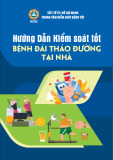
THAI BINH JOURNAL OF MEDICAL AND PHARMACY, VOLUME 14, ISSUE 5 - DECEMBER 2024
96
BREASTFEEDING PRACTICES OF ETHNIC MINORITIES IN NORTHERN
VIETNAM: A POPULATION-BASED CROSS-SECTIONAL STUDY
1.Thai Binh University of Medicine and Pharmacy
2. Vinmec Times City International General Hospital
*Corresponding author: Bui Minh Tien
Email: tienbm@tbmc.edu.vn
Received date: 24/10/2024
Revised date: 11/12/2024
Accepted date: 13/12/2024
ABSTRACT
Objective: Breastfeeding is the most important
and essential practice to help children develop
comprehensively, physically, mentally, and
intellectually. Therefore, this study aimed to explore
the breastfeeding practices among ethnic minority
mothers with children under two years old in two
communities in Muong Nhe district, Dien Bien
province of Northern Vietnam.
Materials and methods: This cross-sectional
study was conducted on 457 Mong ethnic mothers
who had children under two years old in Nam
Khe and Muong Toong communes in Muong Nhe
district, Dien Bien province, Northern Vietnam
from September 2018 to June 2019.
Results: The proportion of children being
breastfed was 90.6%, while the percentage
of mothers who knew about the benefits of
breastfeeding was less than 60.0%.
Conclusion: While the proportion of children
being breastfed was high, the percentage of mothers
who knew about the benefits of breastfeeding was
low. The proportion of mothers who practiced
correctly was higher than the percentage of those
with accurate knowledge of breastfeeding.
Keywords: Breastfeeding; Behavior; Practice;
Mothers; Children under two years old; Vietnam.
I. INTRODUCTION
Breastfeeding (BF) is the foremost important
measure for the comprehensive development of
children, encompassing physical, mental, and
intellectual aspects. Breast milk provides infants
with essential nutrients and disease-fighting
antibodies that promote good health. BF can
reduce the incidence and severity of infections,
lowering neonatal mortality risk. According to the
World Health Organization’s recommendations,
mothers should initiate breastfeeding immediately
after childbirth, exclusively breastfeed for the first
six months, supply appropriate complementary
Bui Minh Tien1*, Trinh Thi Minh Nguyet1, Tran Thi Thanh Xuan2
foods, and continue breastfeeding for up to 24
months or longer [1].
According to estimates by the United Nations
Children’s Fund (UNICEF), breastfeeding in the
first six months can reduce the annual number
of under-5 deaths worldwide by 1.3 million [2]. In
Vietnam, exclusive breastfeeding could contribute
to a 13.0% reduction in child mortality under the
age of five. Early initiation of breastfeeding and
exclusive breastfeeding for the first six months
could lead to a 22.0% reduction in neonatal deaths
[3]. Globally, the rate of early breastfeeding is low
in many regions: Eastern Europe-Central Asia
(17.0%), Asia-Pacific (33.0%), Latin America-
Caribbean-North and East Africa (50.0%). The rate
of exclusive breastfeeding for the first six months
is 39.0%, although there are significant differences
between countries and regions. In some Southeast
Asian countries, the rate of exclusive breastfeeding
for the first six months is not too high. For example,
this rate in East Timor is 30.7%, in the Philippines
is 33.5%, and in Indonesia is 39.5%. Meanwhile,
Cambodia stands out with a significantly higher rate
of 68.0%. Previous studies showed that the practice
of breastfeeding is influenced by factors such as
ethnicity, living area, cultural and religious rituals,
educational level, economic conditions, and family
pressures related to the nurturing and development
of young children. Additionally, factors such as
maternity leave policies and advertisements of
infant formula companies for children under 12
months also affect breastfeeding practices [4].
Consequently, an investigation into the dynamic
relationship between ethnicity and breastfeeding
becomes pressingly imperative.
Dien Bien is a border province in the northwest
region of Vietnam with a vast territory and challenging
transportation. There are resident 19 ethnic groups
in Dien Bien province, with the Mong ethnic group
being the second most populous in the province. In
this area, outdated customs are maintained among
the province’s resident population regarding infant
feeding, which is the main barrier preventing the
development of the rates of malnutrition and
child mortality. According to the National Nutrition
Surveillance Survey in 2010 conducted by the

THAI BINH JOURNAL OF MEDICAL AND PHARMACY, VOLUME 14, ISSUE 5 - DECEMBER 2024
97
National Institute of Nutrition in collaboration with
UNICEF, the rate of first-hour breastfeeding was
98.0%, while the rate of exclusive breastfeeding
for the first six months was 6.1%, and the rate of
predominant breastfeeding in the first six months
was 16.0% [5]. To understand the breastfeeding
practices of Mong ethnic mothers, we conducted
the present study to explore the breastfeeding habit
of Mong ethnic mothers with children under two
years old in two communes of Muong Nhe District,
Dien Bien Province, Northern Vietnam.
II. Methods
2.1. Study Design and Participants
This cross-sectional study was conducted on
mothers with 0-24-month-old children living in Nam
Ke and Muong Toong communes, Muong Nhe
district, Dien Bien province, Northern Vietnam from
September 2018 to June 2019.
2.2. Study sample
To be enrolled in the present study, Mong ethnic
mothers with 0–24-month children needed to
satisfy each of the following criteria: be a resident
of the selected commune; not have mental health
issues or be able to respond to the questionnaire
and agree to participate in the interview.
The study sample size was calculated
using the formula below:
n: the required sample size.
α: the significance level (α = 0.05).
Z(1-α/2): the Z-value corresponding to the chosen α
value (Z(1-α/2)= 1.96).
ε: the desired margin of error, set at ε = 0.16.
p: the proportion of infants who were exclusively
breastfed in the first few hours after birth, estimated
at p = 25.0% [6]. This calculation yielded n = 451
participants. The present study was conducted on
457 mothers.
2.3. Data Collection
Direct interviews were conducted with mothers
of children aged 0-24 months using a standardized
questionnaire prepared in advance. The data-
collecting process included 5 steps. Firstly,
the survey tools were constructed, tested, and
refined before interviewing study participants.
Secondly, study staff were trained to interview
study participants. The third - fifth steps include:
interviewing with mothers, collected data were
compiled and cleaned.
2.4. Data Analysis
The collected data were cleaned and entered into
Epidata 3.1 software and analyzed using SPSS
13.0 software, employing appropriate statistical
tests for medical research. Continuous variables
were checked for normal distribution before
analysis. If the data followed a normal distribution,
parametric tests such as the t-test for comparing
means and ANOVA (F-test) for comparing multiple
means were used. If the data did not follow a
normal distribution, non-parametric tests such as
the Mann-Whitney test for comparing means and
the chi-square test for comparing proportions were
employed. Meanwhile, categorical variables were
presented as frequencies and percentages and
were compared between respective groups using
Chi-square or Fisher’s tests. A p-value < 0.05 was
considered statistically significant.
2.5. Ethical Approval
All participants were provided with specific
and clear explanations regarding the purpose
and content of the study, ensuring voluntary and
cooperative participation. The personal information
of the participants was treated as confidential and
used solely for research purposes. Participants
had the right to refuse participation. Health stations
in the selected communes and the Muong Nhe
district Health Center in Dien Bien province were
informed about the study’s details.
III. RESULTS
3.1. Characteristics of participants
Table 1. Demographic characteristics of study participants by communes (n = 457)
Characteristics
Nam Ke
(n = 212)
Muong Toong
(n = 245)
Total
(n = 457)
n (%) n (%) n (%)
Age group
<18 15 (7.1) 18 (7.3) 33 (7.2)
18-30 153 (72.2) 174 (71.0) 327 (71.6)
>30 44 (20.8) 53 (21.6) 97 (21.2)

THAI BINH JOURNAL OF MEDICAL AND PHARMACY, VOLUME 14, ISSUE 5 - DECEMBER 2024
98
Characteristics
Nam Ke
(n = 212)
Muong Toong
(n = 245)
Total
(n = 457)
n (%) n (%) n (%)
Educational
level
Unable to read &
write 95 (44.8) 153 (62.4) 248 (54.3)
Primary school 86 (40.6) 37 (15.1) 123 (26.9)
Senior high school 31 (14.6) 47 (19.2) 78 (17.1)
High school 0 (0.0) 5 (2.0) 5 (1.1)
Intermediate degree
and above 0 (0.0) 3 (1.3) 3 (0.6)
Occupation
Farmer 209 (98.6) 238 (97.1) 447 (97.8)
Workers, officials, or
business 3 (1.4) 7 (2.9) 10 (2.2)
The study sample consisted of 457 Muong ethnic mothers with 0-24-month-old children. Slightly more
than 70.0% of study participants were aged from 18 to 30 years. More than one-half of the mothers
participating in the study were illiterate at the education level. More than nine of ten study participants
were farmers (97.8%) (Table 1).
3.2. Breastfeeding behaviour
Table 2. The proportion of mothers who are aware of the benefits of breastfeeding for the mother
according to educational level.
Educational level
Benefit
Unable to
read & write
(n = 248)
Primary
education and
above
(n = 209)
Total
(n = 457) p-value*
n (%) n (%) n (%)
Body recovers fastly 163 (65.7) 144 (68.9) 307 (67.2) >0,05
Uterine contracts well 148 (59.7) 118 (56.5) 266 (58.2) >0,05
Reduce breast diseases 160 (64.5) 109 (52.2) 269 (58.9) <0,05
Delayed return to fertility 67 (27.0) 71 (34.0) 138 (30.2) >0,05
*Fisher exact or Chi-square test.
The proportion of mothers who were aware of the benefits of faster postpartum recovery was nearly
70.0%. There was a statistically significant difference in the proportion of mothers who were aware of
the benefits of reducing breast diseases between the illiterate group (64.5%) and the group with at least
primary education (52.2%) (Table 2).
Table 3. The proportion of mothers who are aware of the benefits of breastfeeding for the child ac-
cording to educational level
Educational level
Benefit
Unable to
read & write
(n = 248)
Primary
education and
above
(n = 209)
Total
(n = 457) p-value*
n (%) n (%) n (%)
Safe for the baby 167 (67.3) 149 (71.3) 316 (69.1) >0,05
Enhances immune system 155 (62.5) 125 (59.8) 280 (61.3) >0,05
Helps baby grows 166 (66.9) 123 (58.9) 289 (63.2) <0,05
Enough breastmilk for 6 months 81 (32.7) 66 (31.6) 147 (32.2) >0,05
*Fisher exact or Chi-square tests

THAI BINH JOURNAL OF MEDICAL AND PHARMACY, VOLUME 14, ISSUE 5 - DECEMBER 2024
99
Nearly one-third of study participants knew about the benefits of exclusive breastfeeding for six months.
Meanwhile, the proportion of mothers who were aware of the other benefits ranges from 61.3% to 69.1%.
There was a statistically significant difference in the proportion of mothers knowing about the benefits of
promoting child development between the illiterate group and the group with at least primary education
(Table 3).
Table 4. The proportion of mothers aware of the benefits of immediate breastfeeding after child-
birth according to educational level
Educational level
Benefit
Unable to
read & write
(n = 248)
Primary education
and above
(n = 209)
Total
(n = 457) p-value*
n (%) n (%) n (%)
Breastfeeding exercises for baby 122 (49.2) 102 (48.8) 224 (49.0) >0,05
Breastmilk includes many
antibodies 54 (21.8) 104 (49.8) 158 (34.6) <0,05
Unknown 83 (33.5) 63 (30.1) 146 (31.9) >0,05
*Fisher exact or Chi-square test.
Table 4 shows the proportion of mothers who knew about the benefits of immediate breastfeeding after
childbirth. Nearly one-half of the study participants knew about the benefits of stimulating the baby’s
sucking reflex. There was a statistically significant difference in the proportion of mothers knowing about
the benefits of containing more antibodies in colostrum between the illiterate group and the group with at
least primary education (Table 4).
Table 5. The proportion of mothers aware of the duration of exclusive breastfeeding according to
educational level
Education level
Time
Unable to
read and write
(n = 248)
Primary
education
and above
(n = 209)
Total
(n = 457) p-value*
n (%) n (%) n (%)
Under 4 months 1 (0.4) 13 (6.2) 14 (3.1) < 0.05
4-5 months 98 (39.6) 78 (37.3) (8.5) >0.05
6 months 44 (17.7) 93 (44.6) 137 (30.0) < 0.05
Over 6 months 71 (28.6) 13 (6.2) 84 (18.4) < 0.05
Unknown 34 (13.7) 12 (5.7) 46 (10.1) >0.05
*Fisher exact or Chi-square tests
Table 5 shows that the majority of mothers exclusively breastfeed their children for 4-5 months (38.5%).
There were still 3.1% of mothers who exclusively breastfed for only the first 4 months (Table 5).
Figure 1. The proportion of currently breastfed children according to mother’s education level

THAI BINH JOURNAL OF MEDICAL AND PHARMACY, VOLUME 14, ISSUE 5 - DECEMBER 2024
100
Nearly nine out of ten children of study participants were still breastfed, with 87.6% and 84.4% among
children of illiterate mothers and mothers with at least primary education, respectively (Figure 1).
Figure 2. The proportion of mothers breastfeeding in public when the child demands to breastfeed
according to the mother’s education level
Figure 2 shows that 97.1% and 96.5% of illiterate mothers and those with at least primary education
breastfeed their children in public when the child demands to breastfeed, respectively (Figure 2).
IV. DISCUSSION
Our study was conducted on 457 mother-child
pairs corresponding to children under 24 months
of age in Nam Ke and Muong Toong communes,
Muong Nhe district, Dien Bien province, Northern
Vietnam. Nearly three-fourths of study participants
were aged from 18 to 30. Since the study was
conducted in two rural mountainous communes,
the main occupation of the mothers was
predominantly farming, accounting for 97.8%, with
only a small proportion (1.4%) engaged in other
occupations such as workers, officials, or business.
The demographic characteristics of participants in
this study, including age groups and occupation
were similar to the study conducted by Duyen Bui
Thi and colleagues in 2013, with the majority of
subjects falling in the 22-30 age group (48.4%), and
64.5% of the mothers engaged in agriculture [6].
The proportion of illiterate mothers in our study was
much higher compared to the studies conducted by
Yen Phi Thi Le and Cam Tu Dang [7, 8]. Therefore,
there is a need to expand the program of universal
education for women in these two communes and
extend it to highland areas.
In our study, the proportion of mothers who
were aware of the benefits of breastfeeding for
themselves was: 67.2% for quick recovery of the
body, 58.2% for good uterine involution, 58.9% for
reducing breast diseases, and 30.2% for delayed
return to fertility. These results were lower as
compared to the study by Cam Tu Dang in the
provinces of Ha Nam, Lao Cai, and Quang Binh,
where the knowledge of breastfeeding benefits
for mothers in reducing the risk of postpartum
haemorrhage was 99.4% [8]. However, the
results of the previous study were obtained after
conducting educational interventions for study
participants. When comparing this rate between
the two groups of illiterate mothers and mothers
with at least primary education, it was found that
the proportion of illiterate mothers being aware of
the benefits of breastfeeding in reducing breast
diseases (64.5%) was higher than the group with
at least primary education (52.2%).
The proportion of mothers aware of the safety
and hygiene benefits of breastfeeding was 69.1%.
Results from our study were higher in the group
of mothers with at least primary education (71.3%)
compared to the illiterate group (67.3%). However,
the difference was not statistically significant.
Similarly, the proportion of mothers being aware
of the benefits of breast milk for child development
was 66.9% in the illiterate group, higher than the
group with at least primary education (58.9%), with
a statistically significant difference. The benefits of
breast milk for the comprehensive development
of children were approved. The study conducted
by Girish S and colleagues indicated that infants
who were breastfed had a lower risk of developing
obesity in adulthood compared to those fed with
formula milk [9]. The risk of diabetes in children
who were breastfed was only 0.61 times compared
to those who were not breastfed. Breastfeeding
increases the IQ and improves the learning
outcomes of children in adulthood. The longer
a child is breastfed, the higher their intellectual

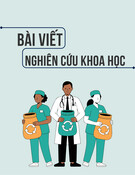
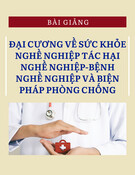
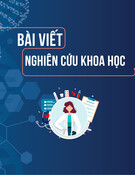
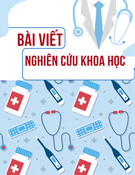
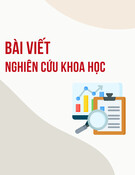
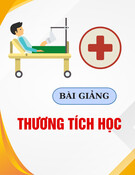




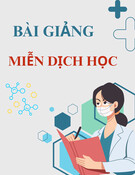
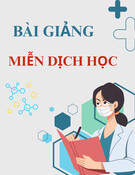
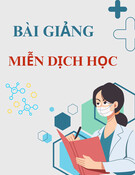
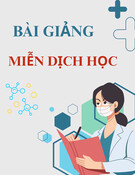
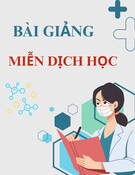
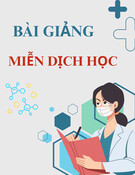
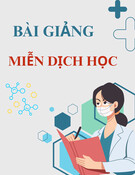
![Cẩm nang chăm sóc sức khỏe cho người bị bệnh xương khớp [mới nhất]](https://cdn.tailieu.vn/images/document/thumbnail/2025/20251022/kimphuong1001/135x160/8611761101317.jpg)
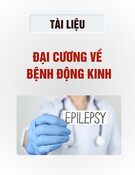
![Giáo trình Chẩn đoán hình ảnh [chuẩn nhất]](https://cdn.tailieu.vn/images/document/thumbnail/2025/20251019/syan5050@gmail.com/135x160/15031761021299.jpg)

